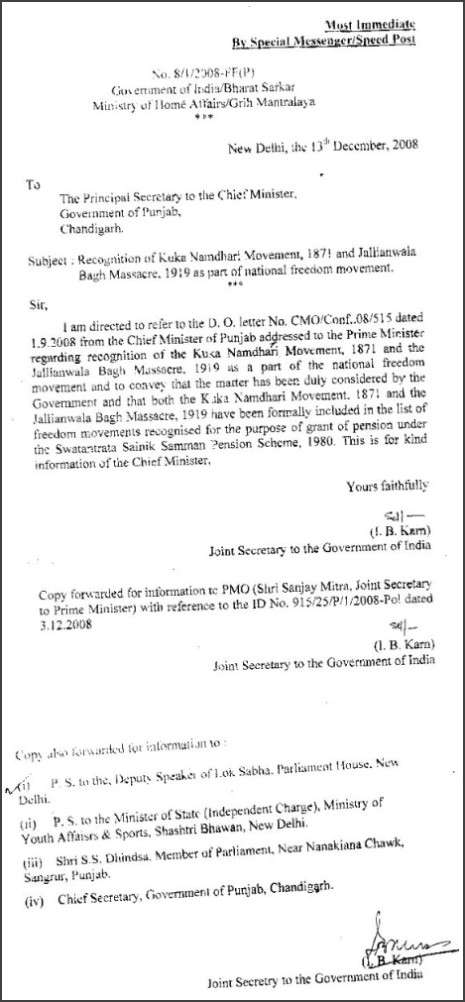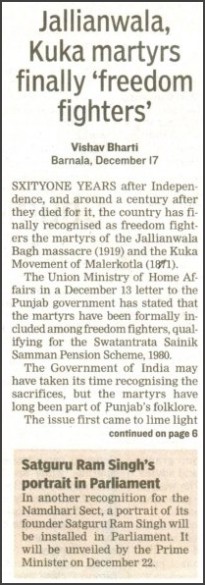namdhari world
Main menu:
- Home Page
- Kuka Faith
- History
- Sikh Gurus
- Namdhari Gurus
- Freedom Fighter - Satguru Ram Singh Ji
- Warrior of Peace
- Non-Cooperation Movement page 1
- Non-Cooperation Movment page 2
- Kuka Postal Service
- No Trial
- Battle for recognition as part of India's struggle for freedom
- Plaque at Ludhiana Railway Station
- Ram Singh Kuka by G.K.Venkateshamurthy
- Social Reforms by Satguru Ram Singh Ji
- Birth of Sant Khalsa
- Kuka Movement - by Film division of Government of India
- KUKA LEHAR - India's first war for independance (1856)
- Satguru Jagjit Singh Ji
- Contradictions
- Historical Quotes
- Vaisakhi - 1699
- Gurmukhi Script
- Sikh Women
- Knowlegde Bank
- Connections
- Places to visit
- Resources
- Music World
- Calendar
- Sports
- ETC...
Battle for recognition as part of India's struggle for freedom
History > Freedom Fighter - Satguru Ram Singh Ji
Satguru Ram Singh Ji's fight for independence finally recognized by Government of India
In 2008, 61 years after independence and almost 138 years after they died for it, the Government of India has finally recognized the freedom fighters of the Kuka Movement. The struggle to achieve this was epic and finally on 13 Dec 2008 the ministry of home affairs put on paper the official declaration. (see transcript below). On 22nd December 2008 , the Indian prime minister unveiled a portrait of Satguru Ram Singh Ji in the parliament of India. His holiness Sri Satguru Jajit Singh Ji graced the occassion.
The sacrifices at Jallianwala Bhag (amritsar) have also been included in the official list of 'freedom fighters'.
That Mahatma Gandhi started the non-cooperation movement against British colonists in 1920 is a well-documented chapter in India's freedom struggle. What many don't know, however, is that the Namdhari sect's founder, Satguru Ram Singh, had started practicing it much earlier in 1871, about 50 years before the father of the nation's initiation.
Mahatma Gandhi had later used the concepts of non-cooperation and civil disobedience propounded by Ram Singh as political weapon against the British. Even India's first president Rajinder Prasad acknowledged this fact of history when India finally attained independence.
Despite their significant contribution to the freedom movement, the Namdhari Sikhs - better known as Kukas – had to wait for more than 150 years to be recognised as being part of the freedom movement.
Having started the movement against the English in 1857, the Namdhari Sikhs got the status of freedom fighters only , in December 2008, when Union government allowed benefits for their descendants under the Sainik Swatantar Samman pension scheme. This came after historian Malwinder Singh Waraich filed a petition in Punjab and Haryana High Court in 2003, for granting the status of c freedom fighters to Kuka and Jallianwala Bagh martyrs.
Agitated by the British forces treating them like slaves, founder of the Namdhari Sikh sect Satguru Ram Singh had started the non-cooperation move that finally grew into a full-fledged struggle against the English. The movement reached a crescendo in 1872 when 66 Kukas were blown off with cannons by British forces at Malerkotla. Earlier five Kukas were killed at Amritsar, three at Raikot and two at Ludhiana.
The Kuka memorial - Malerkotla
Given by its contribution to India’s freedom struggle and fight against social evils, then chief minister of Punjab, Beant Singh had in 1993 commissioned a memorial on six acres of land at Malerkotla in memory of the 66 martyred Kukas. The memorial, a 35 feet-high steel minaret was completed only a few of years ago.
In 1872, 66 brave Namdhari warriors, including an adolescent, were blown to death, at the mouth of the cannon. Their lives and deaths became the lore of India's struggle for freedom. Till recently, they were known only through school history books, alongside the chapter on India's struggle for freedom after 1857, however, thanks to proffessor Malwinder Singh Waraich these pioneers of the movement have finally got a name.
Research by Malwinder Singh Waraich
Waraich, who is now settled in Saketri village near Chandigarh, is known mainly for his biography on Shaheed Bhagat Singh, which was commissioned by the Indian government. He stumpled onto the subject of the Kookas' contribution to the freedom struggle when he was asked to write a chapter on the Namdharis for a series on Sikh history by Shiromani Gurdwara Prabandhak Committee (SGPC) for the 300 year celebrations of Khalsa. Through painstaking research, he not only dug out the names, but also valuable records related to the episode, which finally brought official recognition to this battle as part of Instruggle for freedom from the British.
"While discussing the concept for this chapter, Sikh scholar Kharag Singh asked me to attach a list of names of the warriors and I agreed to do so. But, when I started my research, there were no names to be found" Waraich said. He then got material from another Sikh scholar Bhai Nahar Singh's research on the subject, but the names remained elusive till his experience of being a criminal lawyer gave him the lead.
"The available information had revealed that a group of 150 Namdharis had attacked the armoury and treasury of Malerkotla estate on January 15,1872, and had further planned to attack the Patiala estate. They faced tough resistance at Malerkotla and took shelter in a forest near Rarrh village but were caught by the British forces. The Kukas were then arrested and taken to Amargarh postation and kept for the night from where they were taken to a fortress in Sherpur. They were brought to Malerkotla on January 17 evening where seven cannons arranged by British administrator Cowan, who was also the DC of Ludhiana waited for them," Waraich revealed.
The administrator was in such haste to 'teach a lesson' to the war that he immediately gave the orders of tying them to the mouth of the cannon and blowing them to death, without getting into the full trial. "Probably, this was the reason why no record is available in the national archives, but I knew that everyone kept in a police station for over 24 hours would definitely be a part of some record", Waraich said.
On April 27,2005, he finally found a file in Patiala Estate records which had an account of the arrested persons. "The file was in Urdu and carried technical terms, so it took me some time to decipher it," said the professor in Humanities. He added that the list had meticulously recorded details in various categories of names, the father's name, the caste, village, tehsil and even whether the person had suffered injuries.
Realizing that the battle had not been given recognition as part of India's struggle for freedom, Waraich, armed with the record gathered by him, filed a PIL in Punjab and Haryana High Court in 2003. This was finally recogonised on 13 Dec 2008 at the ministry of home affairs.
As the Union government in 2008 started pension and other benefits, as admissible to freedom fighters, to descendants of Kuka martyrs. However, as only up to the third generation of family members are eligible to get the pension, none of the martyrs' descendants are getting the benefits as they happen to be the fourth or fifth generation. The matter was addressed with the Union government.
Martyr Hira Singh's descendant Bishambar Singh said once the government has accepted the movement as part of India's freedom struggle, benefits provided to kin of freedom fighter should be provided to them also.

